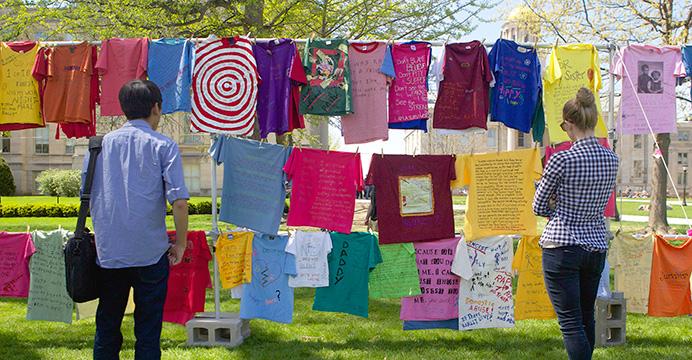 |
A brightly colored shirt shifted in the breeze on the Pentacrest, its message loud and clear. It read: “Domestic Violence, 1 in 4 … It affects us all.” Other bright short sleeves with similar messages hung around the shirt — all representing the effect of interpersonal violence.
The shirts were hung on a long clothesline on the Pentacrest Tuesday as part of the Clothesline Project, a national campaign to raise awareness of sexual assault and domestic and homophobic violence.
“It’s just kind of eye-opening to see how many [there are],” University of Iowa junior Anthony Sansone said. “It’s a good physical and qualitative way to show that this is a problem here.”
“Sometimes, a number doesn’t sit with people; you have to see actual outcomes.”
The Clothesline Project highlights the survivors of violence by allowing them to decorate a shirt reflecting their experience. The Rape Victim Advocacy Program sponsored the event, which has taken place for almost 20 years. RVAP began collecting shirts in 1995 and continues to add more each year.
“Violence is an issue, but if we don’t keep survivors in the conversation, we’re failing them,” said Susan Janis, the university prevention-education coordinator for RVAP. “We can talk about it abstractly, but we need to remember these are real people who are experiencing these things, and we need to honor their experiences.”
Janis said sometimes she thinks it is easier to talk about violence as an abstract thing, but a project such as this one makes people see the effect this type of violence has and how widespread it can be.
Survivors of sexual assault, battered or assaulted victims, survivors of incest or child sexual abuse, victims attacked because of sexual orientation, and those who have passed away because of violence were all represented through specific colored shirts. The project is one of the last of RVAP’s Sexual Assault Activism Month awareness events.
Alex Skalla, who works for RVAP and is an Iowa Sexual Assault Hotline advocate, said she thinks it is important for this event to be located on campus.
“It’s really important just to have this visual message out for people to see, and sometimes that can speak way louder than words,” she said. “A lot of people see one side of the story from the media so I think it’s also good to see the survivors perspective.”



